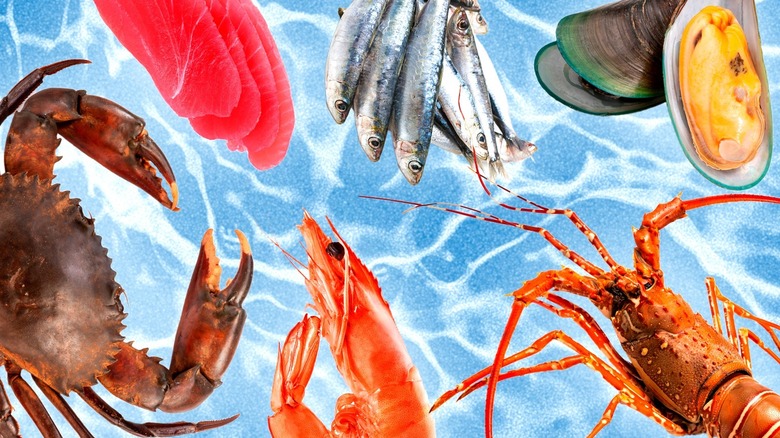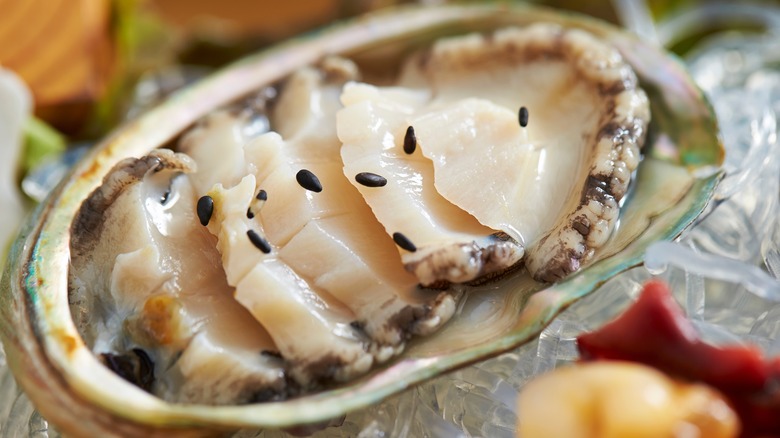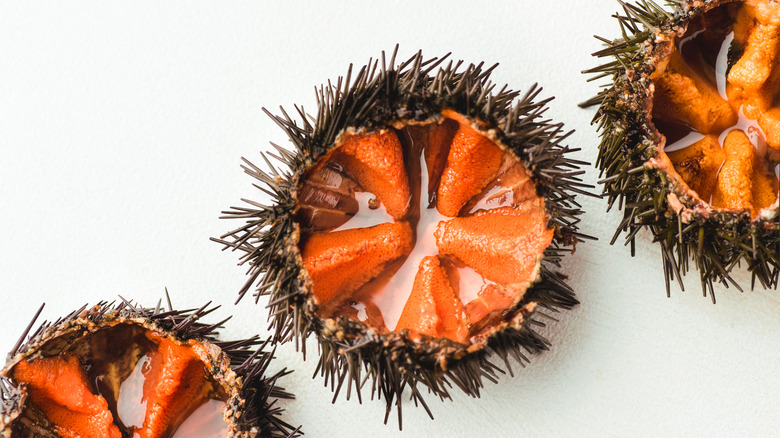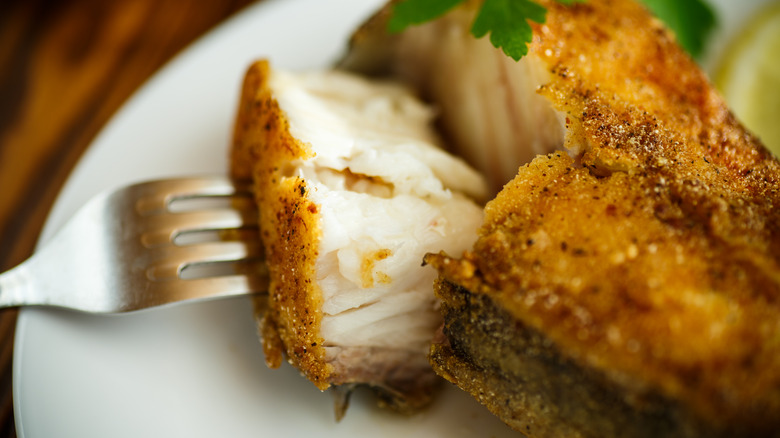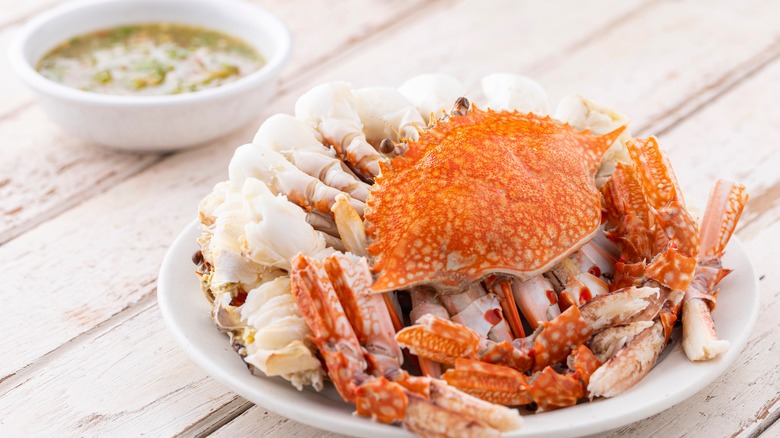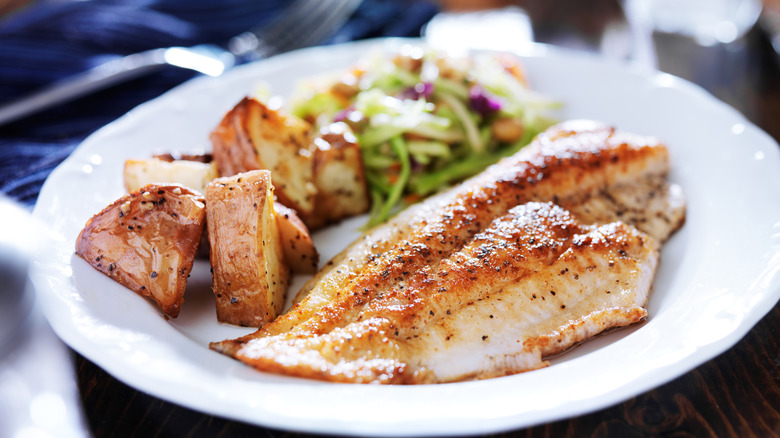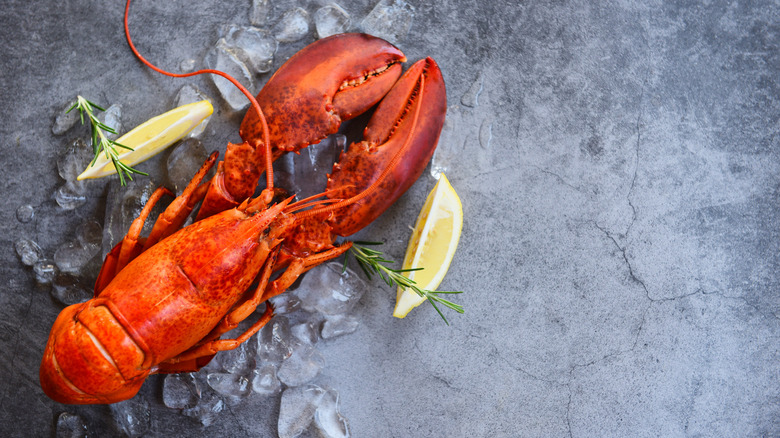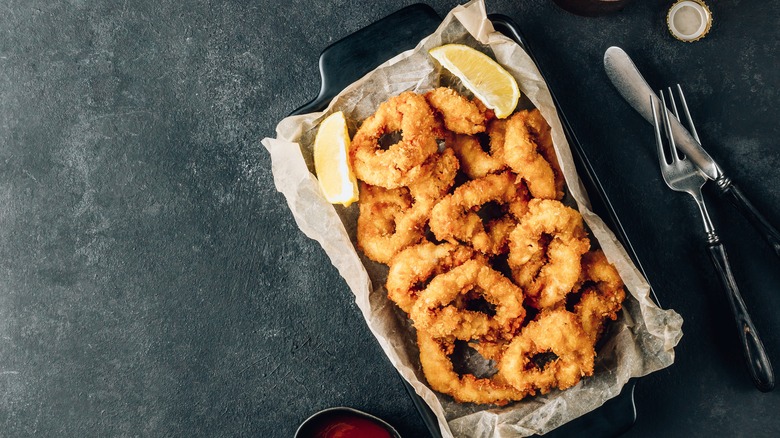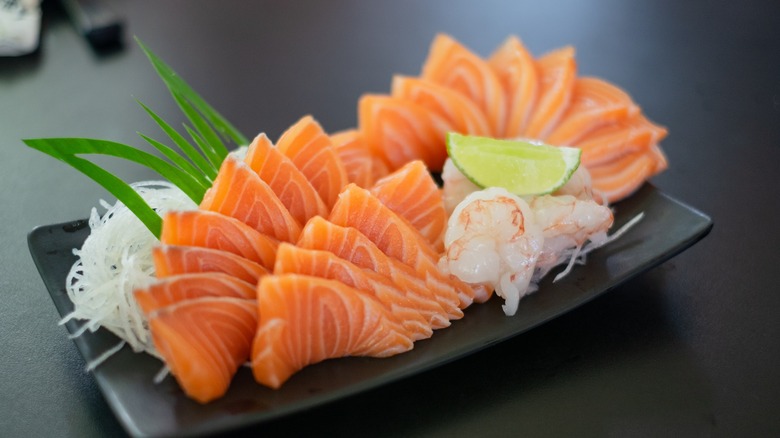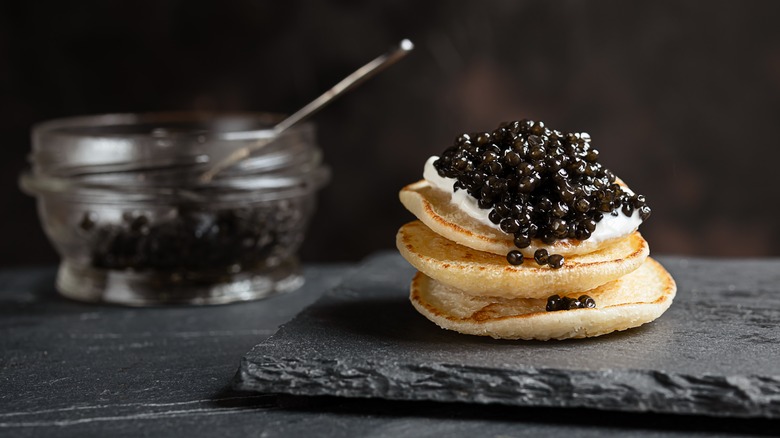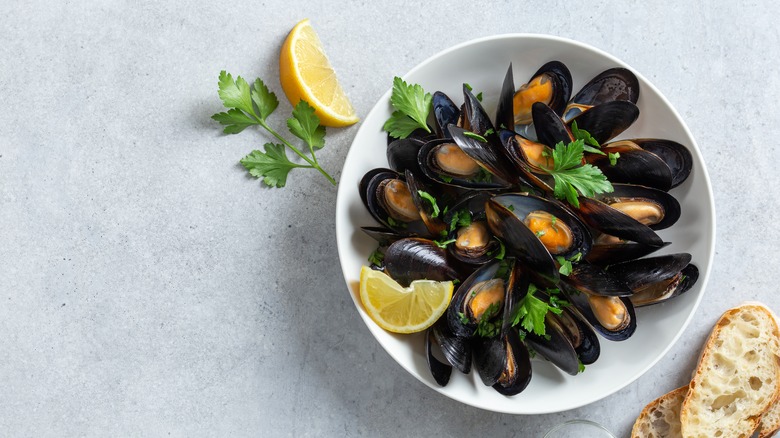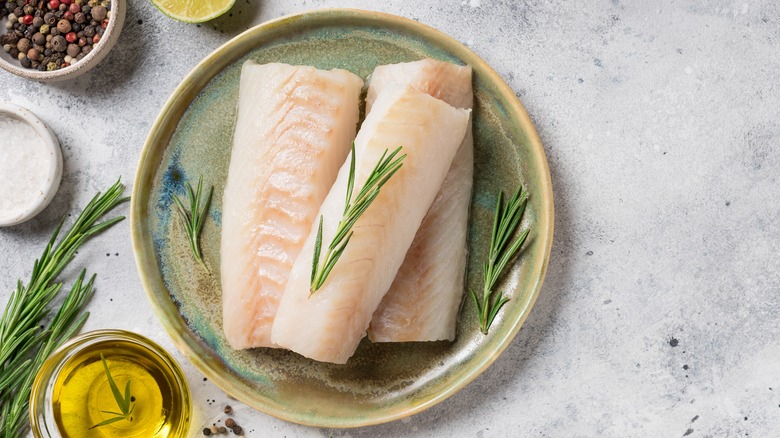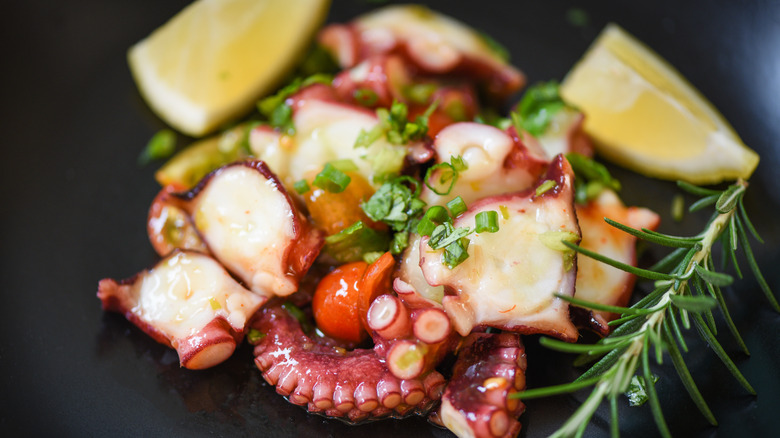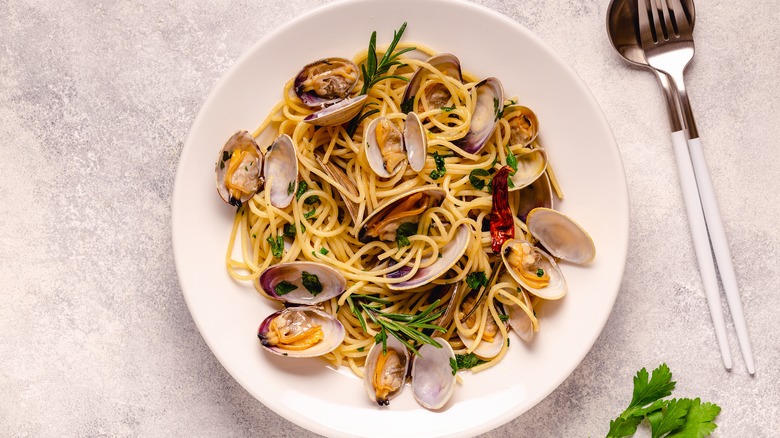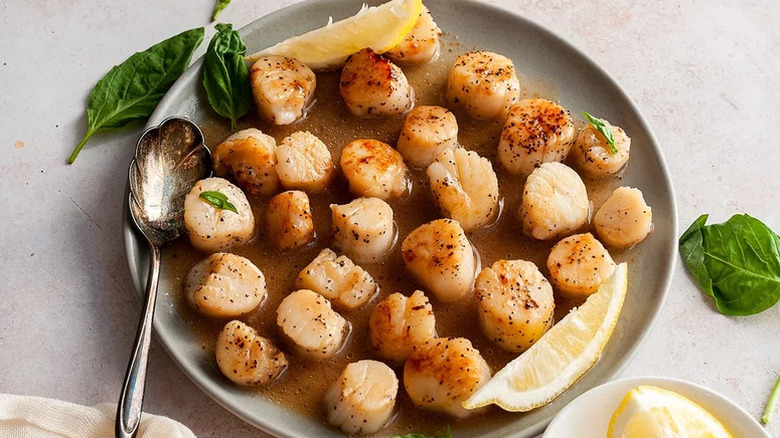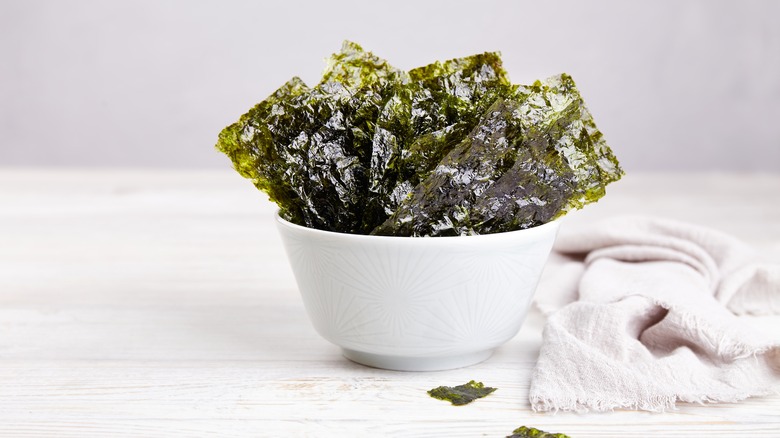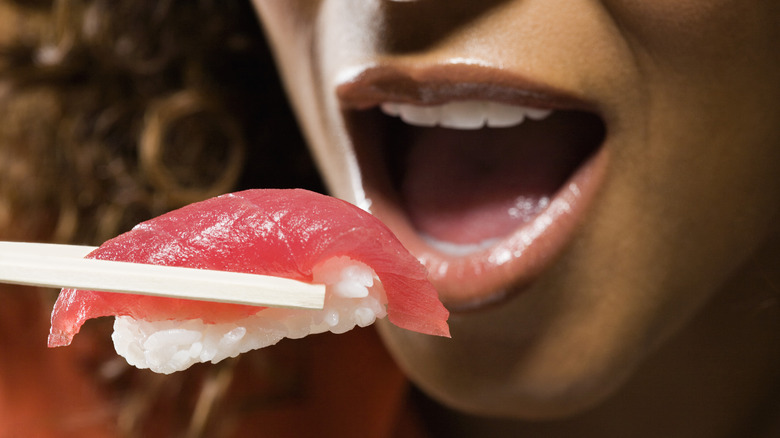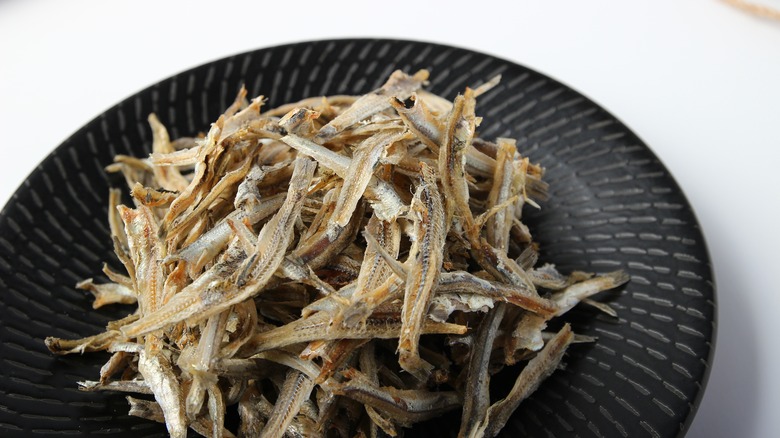20 Popular Types Of Seafood, Ranked
Some love it, others hate it. Seafood may just be one of the most divisive types of food out there. There are those people who have loved seafood from day one — maybe you fit into this category if you grew up in a place where you had access to fresh seafood year-round. Many of us grow up disliking it, only to discover one day that we actually love oysters after actively avoiding them our whole lives. Still, others never get over their distaste for the fishy, salty delicacies that seafood lovers go out of their way for.
But, if you're like most people, you probably love some types of seafood more than others. We've taken it upon ourselves to rank some of the most popular types of seafood. We've started with the varieties we're not as fond of and worked our way to our favorites. Of course, this ranking is subjective — you know best what kind of seafood you like. However, maybe our ranking will get you thinking about your seafood dinner options in a new light. Let's get started.
20. Abalone
If you've had abalone before, then you probably understand why it's a hate-it-or-love-it kind of seafood. In our opinion, the texture isn't bad — it's not dissimilar to calamari, although, it's a bit denser — but we find that the flavor isn't super enjoyable. When it's cooked in the shell (as it often is), you might notice a distinct fishiness to it.
Outside of its shell, it's not especially fishy, but it doesn't pack a ton of flavor. It's slightly buttery and salty, but that's about all it has going for it on the flavor front. Abalone depends on other ingredients to lend it enough flavor to make it something special. Considering that abalone can be quite expensive compared to other types of shellfish, it's not something we're that interested in eating on a regular basis.
19. Sea urchin
The late Anthony Bourdain once told the site Urban Daddy that on a first or second date with a woman, he would take her to a nice sushi restaurant and order the uni, also known as sea urchin roe. Why? Well, according to Bourdain's interview, "If she's immune to the charms of sea urchin roe or unwilling to try it, there's no hope." It looks like we're not Bourdain's type, then.
Sea urchin roe is gorgeous: gleaming orange mounds of soft eggs, just begging to be scooped out of their prickly protective black cages. Scoop some out with a spoon and taste it, though, and you'll be met with a wet, seawater-y glob in your mouth. Blessedly, you don't have to do much chewing before you swallow it, but the few seconds that the uni rolls around in your mouth is less than pleasant, if you ask us.
18. Catfish
Is catfish our favorite type of seafood out there? Definitely not. As bottom feeders, saltwater catfish especially are quite fishy and salty, which isn't to everyone's taste. There are much milder types of white fish out there that are much, much more versatile than catfish. When it's cooked well (i.e., when it's breaded and fried to perfection), it can be pretty good. After all, if you eat fish, you're probably not going to turn down a fish-and-chips situation. But all too often, catfish isn't prepared well, which is why it doesn't rank very high on our list.
If you know how to cook catfish well, though, don't let our ranking stop you from frying some up at home. Since not everyone has a taste for it, you can usually snag catfish for pretty cheap.
17. Crab
Crab meat can be delicious, even a delicacy — and that's why so many of us spend hours at the dinner table, agonizing over how to get those few precious pieces of meat out of a crab's hard shell. If you ask us, it just isn't worth all that hard work. Do you really want to eat a kind of food that requires a tool just to access it? It can be tricky to crack open crabs' legs, and once you go, you get very little meat for all the work you put into it.
Additionally, a lot of crab is kind of lackluster when it comes to flavor. It's vaguely salty, so we have to dunk the meat in butter or cover it with herbs and spices to make it more interesting. Unless we're talking about perfectly fried soft-shell crab, it's just not worth the effort.
16. Tilapia
Doesn't everyone love tilapia? Yes, that's the problem. Tilapia is nearly ubiquitous in restaurants and frozen food aisles, and that's largely because it doesn't have much intensity of flavor. It's just plain white fish that really gets most of its appeal from the other ingredients it's paired with. For that reason, we just can't rank it that highly.
The best part about tilapia, though, is the fact that it's so versatile. Whether you're frying or poaching your tilapia, it's probably going to come out tasting great. If you're trying to work some fish into your diet but don't love seafood, tilapia may be the way to go. However, if you're the kind of person who actually enjoys eating fish, tilapia may seem lackluster if you have it too often.
15. Lobster
Back in the day, lobster was considered so unappetizing that the shellfish was fed to prisoners. In fact, some of the prisoners considered it cruel and unusual punishment to be required to eat so much of it. Of course, times have changed, and lobster is now considered a delicacy. This is really a matter of economics more than taste, though. Lobster is expensive, so it confers status. But, actually, eat some lobster and pay attention, and you'll notice that it doesn't taste like very much at all.
Sure, lobster can be delicious, but that's usually when it's smothered in mayo or covered in a generous serving of butter. And once you take the price into consideration, you have to wonder whether it's worth it at all. We wouldn't turn down lobster if someone served it to us, but we wouldn't go out of our way to drop some serious cash on it either.
14. Squid
Most of us are most familiar with squid in the form of calamari, and it's arguably pretty hard to hate calamari. That's because when you batter and deep-fry anything, it's probably going to taste good. Even avowed seafood haters can still enjoy a plate of calamari — especially if it comes with a good dipping sauce. However, calamari doesn't exactly stand out. The chewy texture is the most enjoyable part of the equation. Otherwise, it just tastes ... fried.
If you want to expand your squid horizons, you should try it sauteed. If you're not used to eating squid without the breading, it may take some time to get over the distinctly squid-like appearance of the dish, but trust us when we say it really is delicious.
13. Salmon
We know, salmon lovers, that you're probably wondering why salmon isn't further down on our list. Well, that's because in a lot of cases, salmon just tastes ... blah. It all depends on how it's prepared, though. Raw salmon, like the kind served on sushi and poke bowls, is delicious. It's rich, buttery, and fatty, and it's perfect when it's served cold. Add some rice to the equation, and you have a near-perfect meal.
But, when it's cooked, salmon loses some of its appeal. The flavor is reduced to a whisper of what you taste in its raw form, and you need a ton of herbs and seasonings to make sure the salmon doesn't taste like nothing. Sure, if it's cooked well, the texture of cooked salmon can be pleasant, but ultimately, there are much, much more delicious fish options in the sea.
12. Shrimp
Shrimp is the most popular type of seafood in the U.S., which we found a bit surprising. That's because shrimp has a very particular texture to it that doesn't appeal to everyone. It's distinctly fleshy and biting into cooked shrimp forces diners to face its bouncy texture head-on. For some of us, that texture is really pleasant, and it complements shrimp's mild flavor. Shrimp haters, on the other hand, dislike the texture, preferring the less-firm flesh of other fish.
Since shrimp does have such a mild flavor, the appeal mostly comes from the other ingredients involved. Shrimp tossed with chili sauce and aromatics is a dream come true, but fried shrimp? We could take it or leave it. Because of its versatility and widespread popularity, shrimp comes in around the middle of our ranking.
11. Caviar
Caviar is one of the world's most recognized luxury food products, so you may have expected it to come closer to the top spot in our ranking. But, price isn't necessarily correlated with value, which is why caviar falls in the middle of our ranking. Sturgeon fish eggs are briny and fishy — a flavor combination we love but one that not everyone is partial to. The real joy of caviar, though, may just be the texture: The little balls roll around on your tongue, making for an undeniably sensual dining experience.
But, we just can't rank caviar higher on our list in good conscience when it comes at such a high price. If you can try caviar without paying the big bucks for it, you totally should — it's delicious. However, most of the time, we just don't think it's worth the incredibly high price tag.
10. Sardines
It's no secret that seafood generally isn't the most sustainable kind of food on the market. If you still want to eat your seafood, but are seeking our more sustainable alternatives, then you may want to turn to sardines. Smaller fish like sardines tend to be significantly more sustainable than their larger counterparts like tuna and salmon, so it's a great option when you're being conscientious of the impact your diet has on the environment.
But, we don't just love sardines because of the sustainability factor. Their intensely salty flavor can also spice up just about any dish. Add some sardines to your pasta for an easy pantry meal, or break them up and spread them on toast with some tomato and garlic for a painfully easy (and surprisingly sophisticated) lunch.
9. Mussels
Admittedly, the appearance of mussels can be off-putting for those who aren't used to eating them. That being said, if you can get over their appearance, you're probably going to like them. They mostly just taste salty, but they can take on the flavors of whatever you cook them in. We love steaming them in wine or beer with plenty of aromatics — the broth that's created in the process may even be better than the mussels themselves.
Wondering how you should eat your mussels? If you ask us, there are few pleasures in this life greater than enjoying a mussels with fries recipe, a combination that hails from Belgium. The freshness of the steamed mussels pairs perfectly with the salty, fried potatoes, making for a relatively light meal that's essentially guaranteed to satisfy seafood lovers.
8. Cod
If you've ever purchased cod before, you know it can be pricey. But, if you're in the mood for white fish, we think it's worth spending the extra money to spring for cod. Since cod is such a big fish, you're going to get thick, juicy filets that soak up the flavor of whatever you cook them in, which is why we think poached cod is such a treat. The flavor of the cod itself is quite mild and lacks a super-fishy quality. This makes it a great choice for those who don't typically enjoy seafood.
Because of this mild flavor, in some cases, cod can be pretty boring — it all comes down to how it's cooked. If you're preparing it yourself, don't skimp on the spices and seasonings: They can make or break the dish.
7. Octopus
Eating bad octopus is a deeply unpleasant experience that we wouldn't wish on our worst enemy, which is why we're sometimes skeptical of ordering the octopus at a restaurant we don't know much about. But, we keep taking the chance again and again because when it's cooked well, octopus is really, really delicious.
In its best form, octopus gets nice and crispy on the outside — it's even better if the octopus' suckers get charred in the cooking process. On the inside, though, the meat is moist and delicate, offering a dynamic experience in a single bite. If you're a person who loves a lot of interesting textures in their food, octopus probably comes pretty high on your list as well. Add in some subtle seasonings, and it's no wonder why octopus ranks so high on our list.
6. Clams
Don't like mussels but still want to get in on the shellfish game? If so, clams are probably what you're looking for. In our opinion, clams have a cleaner, purer flavor that makes them even more appealing than some of their other bivalve counterparts. Of course, there are a ton of different clams to choose from, but we prefer the smaller varieties, like littlenecks. If you enjoy raw clams, this is probably your go-to variety as well.
Even cooked clams can be delicious, though, and if you've never made them yourself, you should give them a try. They're surprisingly easy to steam, and they take on the flavor of the broth, garlic, and wine you add to your cooking vessel. It's hard to mess them up, which is why we think they're such a great option for those learning how to cook seafood.
5. Scallops
Are you interested in learning to cook more seafood at home? If so, you'll probably want to stay away from scallops, at least until you get the hang of cooking fish. It can be tricky to work with in the kitchen, which leads many to believe they just don't like scallops that much. However, if you've ever had scallops that are prepared well, then you know just how delicious they can be. Their firm texture has an almost buttery quality to it that makes every bite feel like a little taste of luxury.
Seared scallops are amazing, but if you truly want to experience the best that scallops have to offer, you'll eat them raw. They have a natural sweetness that's really allowed to shine when they're uncooked.
4. Oysters
There are few joys greater than slurping down some oysters with a glass of sparkling wine in hand, especially if you're sitting somewhere overlooking the ocean. Some people are turned off by the appearance of raw oysters, but once you get a taste of that super-salty liquid and the slippery texture, you'll see why they're such a celebrated delicacy. Few foods pack so much flavor into a single bite. Yes, you can add accouterments to your raw oysters, but you don't need them — raw oysters are just amazing on their own.
Of course, you don't have to eat them raw to enjoy all that oysters have to offer. Grilled or baked oysters, when outfitted with cheese and chives, can be just as delicious as their raw counterparts.
3. Seaweed
When we discuss seafood, there is one ingredient that almost always gets unfairly overlooked. Sure, we've covered a lot of different types of fish and other sea creatures, but seaweed is seafood just as much as salmon is. When it comes to the sustainability factor, seaweed blows most other types of seafood out of the water — sustainable seaweed is probably one of the best foods we can eat if we want to reduce our carbon footprints.
More importantly for this ranking, though, seaweed has plenty to offer on the flavor front as well. It's one of the few ways to add a seafood-like flavor to a dish without actually incorporating fish, and it's an essential ingredient in sushi, where it plays an important textural role. If you're looking for seafood that's healthy, sustainable, and appealing to almost anyone regardless of diet restrictions, seaweed should be your go-to.
2. Tuna
Unfortunately, it is important for us to think about how sustainable our food choices are when we're deciding what to eat, which is why we don't opt for tuna often — the vast majority of the tuna we eat is produced unsustainably, according to the Economist. However, when we do get a chance to eat it, we're never, never disappointed. Tuna is at its best in its raw form, when it takes on an almost meaty flavor. It's our absolute favorite option for sushi.
But, unlike some other types of fish out there (looking at you, salmon), tuna doesn't lose its appeal when it's cooked. Try your tuna seared on the outside and still raw on the inside for an unparalleled seafood-eating experience. It's the fish that we keep going back to time and time again.
1. Anchovies
This might be an incredibly hot take, but we have to speak the truth. Anchovies are the pinnacle of seafood for a few reasons. First of all, wild-caught anchovies are a relatively sustainable seafood choice, per the NOAA Fisheries. They're not overfished, and they don't tend to produce a ton of bycatch.
But, it's not just about sustainability concerns. Anchovies also pack a ton of flavor in a small package. They can be eaten on their own or with crackers or chips for a burst of intense umami flavor, or they can be cooked down and anchovies can be added to pretty much any savory dish you're making. If you really want to up your seafood game, keep a can in your pantry at all times and add them to whatever you're cooking that needs a burst of flavor. If you're not used to cooking with them, you might just be surprised by the delicious results.
